Blockchain Principles: Understanding Blockchain Technology

While the term ‘Blockchain’ has risen to prominence, many people have a vague idea about what it is. The reality is that many business leaders cannot explain the principles of blockchain technology and how it may benefit their businesses.
Widely recognized as the underlying technology for cryptocurrencies such as Bitcoin, the core principles of Blockchain can potentially be the next big thing – probably the biggest after the internet, driving innovation, efficiency and security in a diverse range of applications.
For those who understand even the basic blockchain principles, it is clear that blockchain technology will continuously evolve and grow with time.
There is much misunderstanding about Blockchain, with most people mistaking it for cryptocurrency, programming language, or framework when Blockchain is a comprehensive technology in itself.
This guide will help you gain a comprehensive understanding of the basics of blockchain technology and the main principles on which blockchain is based.
On this page:
Blockchain Basics
Even though it is called a new tech, the origins of blockchain date back to 1991 when the ‘Journal of Cryptography’ published ‘How To Time-Stamp A Digital Document’.
In 2009, Satoshi Nakamoto published a white paper describing Bitcoin and devised the first database based on blockchain principles. However, since then, it has evolved to something more significant with the increasing popularity of Bitcoin and other digital currencies.
Related: Cryptocurrency 101: Understanding Digital Currency
A Blockchain is a data store that grows continuously – a chain of blocks or a group of transactions distributed among multiple users.
It contains records of transactions that have occurred within a specific timeframe. Each of the entries is immutable; it cannot be edited or deleted after getting into the database.
These transactions also don’t depend on any authoritative entity to validate the data authenticity and integrity. Blockchains typically records financial transactions, but it is possible to store information related to anything.
Digital transactions and records can be easily duplicated. It is therefore vital to have a common digital history. Blockchain solves this issue without the need for any intermediary.
Blockchain, sometimes called Decentralized Ledger Technology (DLT), makes the history of any digital asset transparent and unchangeable, allowing strangers to reach a consensus on a common digital history.
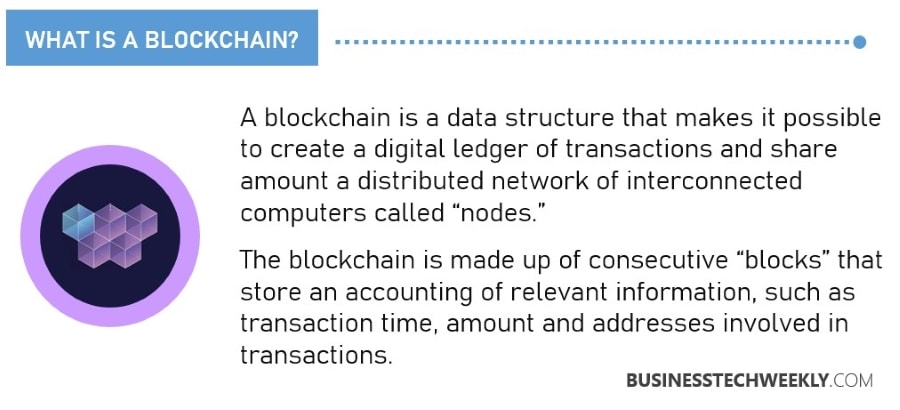
To understand blockchain technology principles better, consider a Google Doc. Whenever you create a document and share it, there is no transfer or copy; it is just distributed. It is an example of a decentralized distribution chain giving access to a piece of data to multiple users simultaneously. No user is restricted access waiting for changes from other parties; all the modifications are recorded in real-time, making them completely transparent.
Blockchain is much more complicated than Google Docs, but the analogy helps understand the critical ideas of the technology.
Blockchain is a highly promising and breakthrough technology. It helps bring transparency, stamp out fraud and reduce risk in a scalable manner. A transparent ledger preserves the integrity of the document, thereby building trust in the asset. The inherent security measures and decentralized nature make it a preferred technology in every sector.
How does Blockchain Work?
The primary purpose of Blockchain is to let untrusting parties securely share critical data. It is a simple yet ingenious way to automate and securely transfer information between two parties.
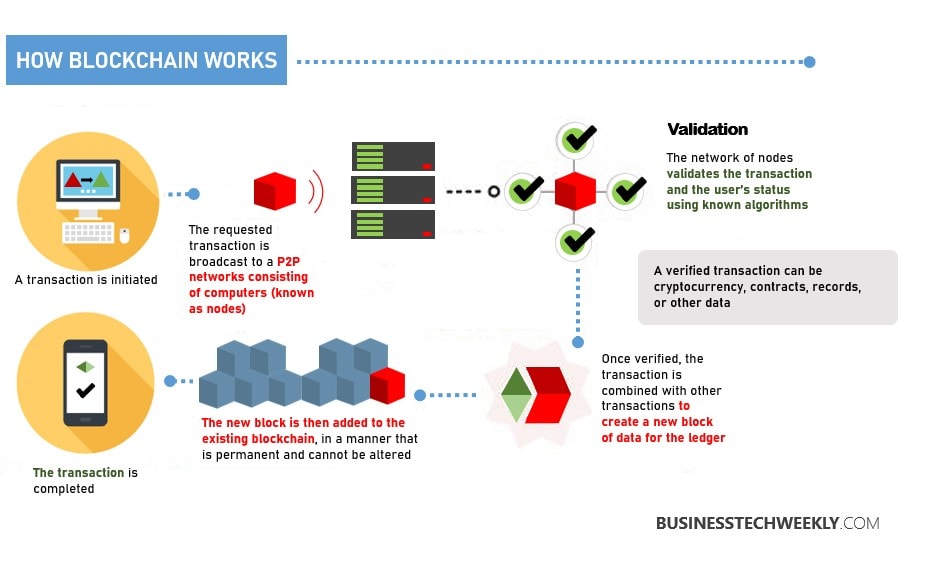
To understand the working of this technology, let’s take a look at the three basic concepts – Blocks, Nodes, and Miners.
Blocks
A blockchain is made up of a large number of blocks. Each block is made up of three elements:
- Data
- Nonce: a randomly-generated 32-bit number that creates a block header hash
- Hash: a 256-bit number starting with lots of zeroes
As the first block is made in the chain, a cryptographic hash is generated, and the data is marked as signed. The block data is tied forever to the nonce and hash unless mined.
Miners
Miners create new blocks on the chain through a process referred to as mining. A unique nonce and hash is assigned to each block on the Blockchain and references the previous block’s hash, so mining is difficult, mainly when the chain is big.
With the help of dedicated software, Miners should solve the complex math problem to find a nonce that generates an accepted hash.
As the none is 32-bits and the hash is 256, the miner should execute about four billion possible combinations to find the right one. When the miner finds this ‘golden nonce’, the block gets added to the chain.
To change any block added earlier in the chain, the miner must re-mine the block and all the blocks coming after. So, manipulating blockchain technology is extremely difficult.
Nodes
Decentralization is one of the most crucial aspects of blockchain technology. Blockchain is a distributed ledger connected via nodes and not owned by a single entity. A node can be any device that holds a copy of the chain and contributes to continuous network function.
Each node possesses a copy of the chain, and a network must approve a mined block to update and verify the chain. As blockchains are transparent, each of the participants can access and view every action on the ledger. A unique alphanumeric ID number is given to each participant showing the transactions.
Nodes can be one of the two types:
- Full Nodes – Such computers have a full copy of the Blockchain containing information from the first block in the chain.
- Lightweight Nodes – This version of nodes contains information from the last few weeks or hours. These nodes are easy to run, but you risk not finding the most accurate or secure information as you rely on others for the data the node misses.
Hosting a node keeps the Blockchain always accurate and up-to-date. Nodes and miners constantly cross-reference each other to create and maintain a blockchain.
When information is stored on multiple machines like this, it is called distributed ledger technology or DLT.
Basic Principles of Blockchain
Blockchain or the distributed ledger technology promises much value for several applications apart from cryptocurrencies.
Its security feature has captured the attention of industry experts and inspired them to explore its possibilities. Much is said about its capabilities and potential to change the way we do business.
However, the complex nature of Blockchain means it requires preparation and time for proper adoption. To benefits from the security and transparency offered by Blockchain technology, businesses should understand how it works and how the initial rules should be set up.
Let’s look at the five fundamental principles that work as the basis of blockchain technology:
Blockchain Principle 1: Distributed Database
Before the advent of BitTorrent and Bitcoin, centralized services were more prominent. Such systems were based on a centralized entity that stored the data, allowing interaction with the entity to retrieve the information needed.
Commonly known as a client-server model, an excellent example of a centralized entity is Google Search. Here, a user sends a query to a centralized entity, namely google search, and receives relevant information.
However, there are some problems with centralized systems:
- All the data is stored in one location, making them easy targets for potential attackers
- If these systems undergo a software upgrade, the entire system halts
- In case the central entity is down, everybody will have to wait to access the information
- If the entity gets corrupted, all the data is compromised
In a decentralized system, information is not stored on any one entity, but rather all the entities in the network hold the data.
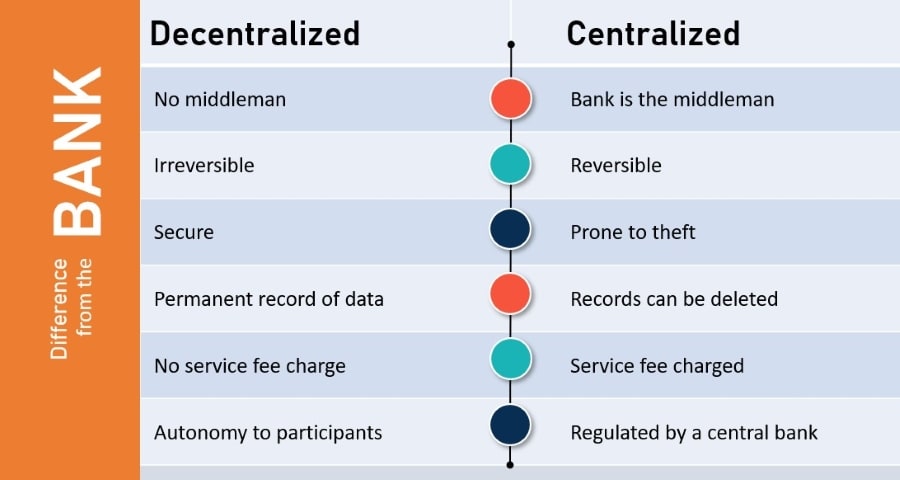
Each party on the blockchain has complete access to the entire database and its history. No third-party entity regulates the data. Anybody on the network can validate the transactions directly without involving an intermediary.
All computers connected to the blockchain via the internet operate the same software. So, even if one or more computers get disconnected, the network doesn’t stop. If all the computers shut down simultaneously, the blockchain continues to store the data in distributed databases. The computers will have a copy of the database from the point it was last updated. Such a feature of blockchain technology makes it highly robust and capable of surviving power outages and other problems.
This principle of a decentralized network is the driving ideology for cryptocurrencies. This type of system allows you to interact with a friend directly without any middleman. If you work with Bitcoins, you are in charge of your money and can send it to anybody without needing to visit a bank. Blockchain facilitates a trustless digital exchange method. By distributing the ledger across computers running the same protocol, this technology eliminates the need for third parties, authorities, and intermediaries.
Without any third-party intervention, users can interact with one another and get rid of paying or trusting any governments, institutions, or corporations. It is a P2P collaboration that services have been using since the early 2000s. The only difference is the ability to store digital information like transactions in an immutable distributed ledger.
Blockchain Principle 2: P2P Network
The Blockchain is maintained by a peer-to-peer (P2P) network of a collection of interconnected nodes. This type of network divides the entire workload among participants who get equal privileges. An internal or external trust authority for the functioning of Blockchain is not required. The data is distributed among users, and all of them have copies of hashed blocks and transactions.
The peers can pass the data of any transaction to the entire network. Since the information is not stored on any individual entity but the network of nodes, nobody can alter the chain data. Once the users validate a data block, it is added to the chain, and all the users update their copies. If an attacker tries to modify data on any local node, the network will not accept an altered block.
A peer-to-peer network has no central authority, and hence the download speed is not dependent on any server. Even if one of the peers doesn’t perform satisfactorily, downloads can be obtained from other peers. Moreover, it is not prone to censorship as it does not have a central system. Using the peer-to-peer model with a payment system has given rise to cryptocurrencies, the revolutionary concept in the finance industry.
The P2P structure in cryptocurrency is created depending on the consensus mechanism used. Currencies like Bitcoin and Ethereum use a Proof of Work method where all the peers are given the same privileges. Nodes are not given any special privilege, but their functions and roles differ. It is a flat topology with no centralized entity or hierarchy. These currencies are structured in this particular way to meet the goal of staying true to their essence.
Bitcoin and Ethereum have a currency system where everybody is treated equally without a governing body. The value is determined based on a whim. A node in the case of cryptocurrencies is a computer participating in the network in one of the three ways:
- As a Light Client by holding a shallow copy of the chain
- As a Full Node by storing the full copy
- Mining by verifying transactions
The only issue with this system is that it is not easily scalable. Hence several modern cryptocurrencies have adopted other protocols. In the case of Neo, EOS, and Cardano, the nodes choose their supernodes, who are given the charge of the overall network.
Such cryptocurrencies are faster but are not the most decentralized. Consequently, cryptocurrencies generally trade-off between decentralization and speed.
Blockchain Principle 3: Computational Logic
As the ledger is digital in nature, transactions in a blockchain are often guided by computational logic. Users in a system generally employ pre-defined rules and algorithms that trigger transactions between nodes in the chain. The concept is beneficial in enterprise markets as the private Blockchain offers nodes to help manage the permissions for transactions.
Operators can manage the capabilities over who reads the records, who can submit transactions, and who verifies them. Blockchain technology is used mainly in business transactions where multiple parties want to participate but don’t trust one another. Private blockchain systems are being tested and implemented for supply chain management, commodities market, and land records.
As these systems are developed, several situations impacting the security of the underlying assets and the system as a whole are encountered. It is essential to take proper security measures to improve the framework’s robustness in its early stages to avoid changing the product to handle security flaws.
Blockchain Principle 4: Consensus Protocol
A real blockchain is where the users need to agree on the chain’s validity before adding blocks. A common protocol guides the validation of blocks every time the node adds them. Each block in a chain has some data or transactions. A miner confirms the block, and new blocks are written every few minutes with a process called mining.
However, new blocks should be validated by nodes, and they follow some methods to verify the correctness of the blocks. Only when the nodes reach a consensus is a new block is added to the chain. With the Proof of Work method, the nodes verify that the new block fulfills the requirements, including validating all the transactions inside the block. If they find them valid, it is added as a part of the Blockchain.
If different users find different chains valid, they select the longest chain as the Blockchain and discard shorter ones. The Proof of Work method for data mining requires creating a block with restrictions on the hash code. As the hash code can have many combinations, the miners should test these possibilities before meeting the requirements. Such restrictions account for the difficulty of the network.
Once the miner finds the right combination, it adds the block to the chain. Every node checks the validity with the Consensus Protocol. If they find the block valid, they add it to their copies of the Blockchain. In a private blockchain, the operator can allow only some nodes to verify the blocks. These are the trusted parties responsible for passing the verified transactions to the rest of the network. Giving access to these nodes is a critical security decision the system operator has to make.
Blockchain Principle 5: Immutable Ledger
Immutability is another significant feature of blockchain technology. Once a transaction is entered into the database, it is impossible to change the records – since each record is linked to other transaction records entered before it. As every block contains the previous block’s hash, you need to modify the entire chain to tamper with a record. This feature allows the chain to work as an immutable ledger.
The immutability of blockchain comes from the cryptographic hash function. Hashing means giving out a fixed-length output for any length of the input. For cryptocurrencies, transactions are inputted and run through a hashing function to give a fixed-length output.
For example, a secure hashing algorithm 256 always has a 256-bit output regardless of the size of the input. This becomes highly relevant when you are handling vast amounts of data. Rather than remembering the input data that can be big at times, you can keep track of the hash.
There are several characteristics a cryptographic hash function exhibits to be appropriate for security different applications demand. One of these properties is the ‘Avalanche Effect’, which implies that a small change in the input reflects more significant changes in the hash. Changing only the first letter of the input affects the output to a great extent.
Let us try to understand why. The Blockchain is essentially a list of linked blocks containing data and a hash pointer pointing to the previous blocks, creating a chain. A hash pointer is made up of the address of the last block and contains the hash of the data inside that block. This principle makes Blockchain so amazingly reliable and secure.
It is clear to see how valuable this feature can be for financial institutions. If a hacker attacks a block and tries to change the data, the hash changes drastically. It affects the previous block, which in turn changes the data in other blocks. The entire chain is modified, which is unacceptable. This is how Blockchain gets its immutability feature. Many approaches and algorithms are put in place to ensure the database recording is always in chronological order, permanent, and readily available to others in the network.
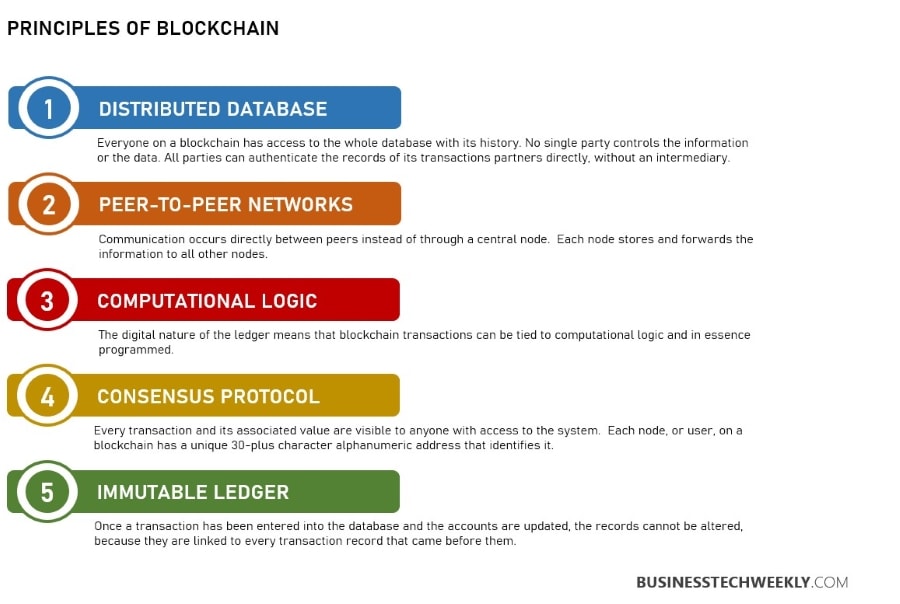
Applications of Blockchain
The most potent use case for blockchain technology comes from the finance industry. Financial institutions were the first to set up R&D labs, built test centers, and collaborated with blockchain developers to stay ahead of the revolutionary change.
Since then, consulting firms, governments, and academia have also worked on the technology to devise new ways to use existing blockchains or create new ones.
Below are some of the typical applications of blockchain technology using the previously discussed principles:
Cryptocurrencies and Blockchain
The most well-known use of Blockchain is in cryptocurrencies. Bitcoin, Litecoin, and Ethereum are digital currencies that can be used like cash to buy goods and services. But unlike cash, these currencies use blockchain technology to record transactions and secure them. There are more than 6,500 cryptocurrencies globally, with a market cap of about $1.6 trillion. Bitcoin holds the majority of the value.
Bitcoins have recently gained much popularity, with one coin costing about $60,000. Here are some of the reasons cryptocurrencies have suddenly become popular.
- The security of blockchain technology makes the currency difficult to steal; each cryptocurrency has an identification number linked to the owner.
- Cryptocurrencies eliminate the need for central banks and physical currency. Blockchain enables anybody to transfer money globally without any interference from banks.
- Digital currencies have the potential to make people rich. As the prices of these currencies rise, some early adopters get a chance to become billionaires.
- An increasing number of corporations across the world are adopting the idea of blockchain-based currencies for transactions. Tesla, in February 2021, announced that it would invest $1.5 billion into Bitcoin and start accepting it as a payment method.
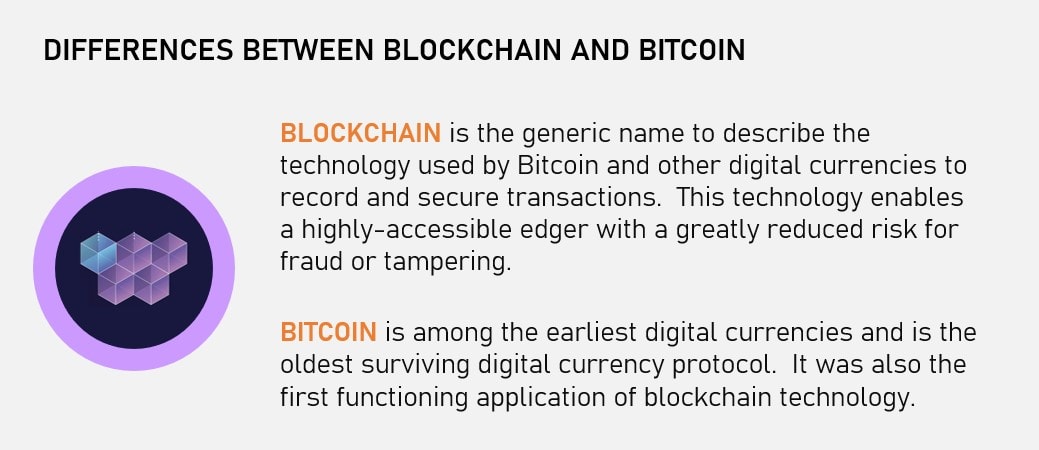
While there are apparent benefits to blockchain-based digital currencies, experts also have some legitimate arguments against them. Firstly, the crypto market is not regulated. Though several governments have quickly jumped into crypto, a few have outlined a set of laws governing the use. Secondly, the currency is highly volatile because of speculators who don’t focus on long-term interests.
Such an unstable nature of cryptocurrencies has made some people rich while others have lost hard-earned money. However, these currencies are appealing because everything gets recorded in a digital ledger and secured through cryptography.
Ethereum Blockchain
Blockchain was developed as a secure, transparent ledger for Bitcoin and has always been linked to cryptocurrencies – though its features and benefits have resulted in growing adoption across various areas. An example of this adoption is the development of the Ethereum blockchain.
In 2013, a white paper proposed a platform based on the traditional blockchain functionality with a difference.
The Ethereum blockchain project included the execution of computer code into a blockchain, allowing developers to make computer programs to communicate with one another on the blockchain. Tokens represent digital assets, track the ownership and execute functionality based on a set of programming instructions. Tokens can be anything from music files in different formats to medical records or even show tickets.
The latest trend in this area is the NFTs (Non-Fungible Tokens) which are blockchain-based tokens used to store digital media like music or video. Each of these tokens can verify its authenticity, ownership, and history. NFTs have become increasingly popular because they offer creators the ability to trade their art while earning profits.
Blockchain Basics: Common Blockchain Use Cases
Some of the latest uses of Blockchain include sectors like security, government and media. Many medium to large-scale companies currently undertake the development and research of products and systems running on this revolutionary technology.
Smart Contracts
Cryptocurrencies were the initial platform developed on blockchain technology. People are moving gradually to smart contracts as a platform for currency exchange. “Smart contracts” are programmed to perform specific functions across industries.
For example, vending machines smart contracts are programmed to engage the machine after receiving a cryptocurrency or send a signal to trigger a blockchain activity.
There are Ethereum smart contracts that control blockchain assets executed over interactions on the platform. A derivative can be set to be paid out upon a specific benchmark for a financial instrument using Bitcoin and Blockchain to automate the payout.
Land Title Registration
Another use case is the land title, as it is beneficial to have access to a decentralized record that shows who owns a piece of land. This approach can be further implied in particular scenarios, such as during a war, where the land has been redistributed without compensation.
As soon as a piece of land has been distributed, the entry can be recorded in the ledger and no longer remains a subject of argument.
Protection of Properties
Blockchain can also establish proof of ownership over any physical asset, including art, instruments, and cars. A physical record of title can degrade, and centralized databases are at risk of human errors, tampering, and hacking.
With blockchain technology in place, there is no centralized entity controlling the database. Thus, recording physical assets on this system is an example of how this technology helps track ownership in a tamper-proof manner.
Supply Chain Management
A highly relevant application of Blockchain is the supply chain. Giant corporations, including Nestle and Walmart, regularly collaborate with IBM to improve food sourcing and tracking operations.
The system aims to create immutable records of where the food items are sourced from to help retailers respond to outbreaks much speedier than they usually do.
Logistics
Ports are also employing this tech to simplify logistics in international trade. Currently, forms and filings are being generated whenever goods are traded, thus creating lots of redundant records, extra costs, and errors. A private blockchain could streamline the processes and build more vital trust among participants.
Governance
Just like sourcing and tracking goods and services, the technology can securely track election ballots.
Some states have started using blockchain-based applications to help overseas troops cast ballots. However, there are some challenges the tech should overcome before blockchain voting can be used widely.
Identity Management
Blockchain technology could also present a potential for identity management. Rather than issuing the identity numbers from the government, it could be verified on an open, global blockchain trusted by all and controlled by no single entity, allowing users to take charge of their own identity. Several companies, including Civic and ID2020, are already working on this project.
DNS
Another application of Blockchain is creating a decentralized internet where users can control their apps and own their data. Blockstack is an example of a decentralized DNS built on Blockchain.
The company has raised $52million for the project. It promises to develop a system that helps users maintain their security, freedom, and privacy. If it becomes successful, Blockstack will likely disrupt the most significant internet giants, including Google acting as middlemen in the present scenario.
Advertising
Blockchain could also apply to a wide range of possible decentralized internet services such as advertising. Recently, Basic Attention Token has become popular as a blockchain-based protocol that aims to improve advertising efficiency by distributing value between publishers, advertisers, and users.
The project is handled by Brendan Eich, the co-founder of Mozilla and Firefox. It uses a blockchain-based token to track-focused user attention on ads while taking care of their privacy.
Trade
Other potential applications of the technology include a system where illiquid assets are traded through blockchain-based tokens. A decentralized market would allow trading ownerships of real estate and other valuable assets in fractions through secure databases without any intermediary.
The 0x project is currently working on implementing such liquidity with the help of its protocol for decentralized asset exchange.
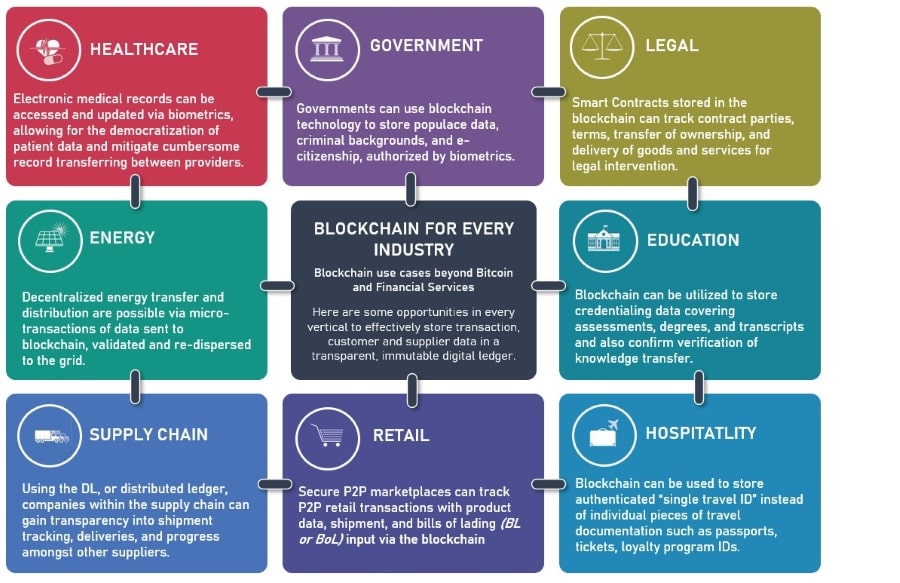
Benefits of Blockchain
The primary value of this technology lies in its ability to store, distribute, verify and record vast volumes of data permanently, including critical transactions without any need for third parties. Blockchain automates the exchange of information across digital media to bring about a revolution across sectors and industries.
Let us discuss some benefits of blockchain technology and its principles:
Immutable Data
Blockchain stored data cannot be changed and is permanent, i.e. immutable. Traditional transactions involving third parties are prone to inefficiency, bloat, and corruption from human intervention. Blockchain technology is capable of automating these aspects to bring about substantial social and fiscal changes.
Bitcoin suggests that the tech can act as an underlying infrastructure for an innovative monetary system. The immutability of this technology makes it ideal for streaming and hosting content. Users can easily create content that cannot be duplicated or stolen, giving them better chances to monetize their work.
Internet giants like Facebook, Google, and Microsoft store your information on their servers. They don’t offer free services but rather monetize your data by collecting your habits and selling to those willing to pay higher than others. A small number of companies dominating the internet is called centralization, resulting in corruption and technological advancement barriers.
Digital Freedom
Cryptocurrencies and blockchains are decentralized, unlike the current technology space. No central authority or company controls the operation or information. The technology aims to challenge the present monopolies existing in the world of technology.
Today, people rely on sharing information and transactions through the internet. Blockchain technology promises to improve this experience by creating endless possibilities to engage without relying on any third party. This will allow blockchain to bring freedom to individuals in the digital world.
Security
Present technological companies are prone to hackers who manage to make their way into our computers and steal personal information.
Security issues have increased to a level that your credit card information and email address could also be stolen. There are entire industries built around collecting valuable data from internet users. This offers a significant disadvantage with centralized systems, as attackers know precisely where the information is stored.
Decentralized systems are free of this limitation. Huge public blockchain ledgers are distributed across thousands of computers.
It is virtually impossible to attack each of these simultaneously. Its unique architecture makes it incredibly secure and robust. Traditional banks, for example, often don’t meet expectations, and you face problems like delays and account freezing. If you send bitcoins, there is no such problem.
Privacy and Anonymity
Cryptocurrencies built on blockchain technology let users carry out their transactions with complete anonymity and privacy without interference from a third party.
With the growth of digitalization, large corporations and government agencies exercise more control over our data. Your habits and information are being collected, making it easier for attackers to take over your life.
Products using Blockchain are working in the direction to change these things. There are cryptocurrencies aimed at facilitating exchanges that can never be traced. Some projects even aspire to build protocols that give users anonymous internet access.
No Intermediaries
Financial institutions, banks, and companies like PayPal and Visa are intermediaries facilitating monetary transactions in the present system. A decentralized blockchain-based trade does not involve any intermediary and hence gives you better control and privacy.
Reduced Costs
Blockchain automates transactions with computer programs to reduce costs to a great extent. The technology space continues to invent low-cost options as competition increases. You can transfer millions of dollars on a decentralized network for a negligible cost. Users will no longer rely on credit card companies and pay hefty transaction fees for online purchases.
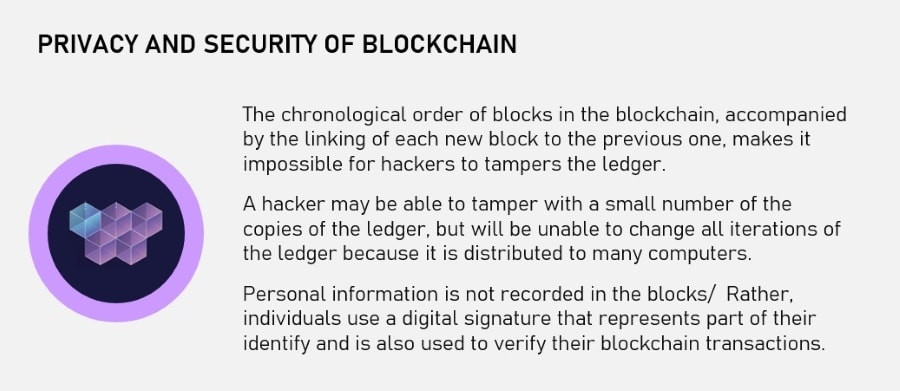
Is Blockchain the future?
Ultimately, blockchain technology and principles provide a new way of thinking about how parties agree upon. For the first time, it facilitates multiple untrusting parties to exchange information and come to standard terms without any intermediary. This revolutionary tech is disrupting and will disrupt any industry that involves transactions and information.
The biggest reason people resist the adoption of this technology is the concern about security and safety. Safer than traditional systems, blockchain, due to its core principles, can better protect users.
Blockchain 3.0
Blockchain 3.0 is a catch-all name for efforts to address current concerns in the blockchain sector, notably scalability, interoperability, and, many would argue, privacy.
Blockchain 1.0 (i.e. Bitcoin) and blockchain 2.0 (e.g., Ethereum) brought distributed ledger technology (DLT) to the public’s attention. Blockchain 3.0 should provide the final push it requires to attain widespread acceptance.
Many of the blockchain 3.0 initiatives are still in their early stages. However, the sheer amount of creative minds working on these blockchain 3.0 solutions should offer hope for the future of blockchain.

